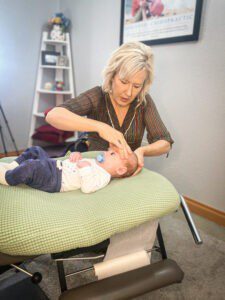WHAT TO EXPECT WHEN YOU TAKE YOUR BABY TO A CHIROPRACTOR
(And is it really safe?)
You have a newborn baby. Congratulations! Like so many other new parents, you’re probably also struggling with breastfeeding and at your wit’s end trying to find help. You’re exhausted, maybe even depressed, and willing to try anything. You probably sought help from a Lactation Consultant who may or may not have suggested that you see a Pediatric Chiropractor. You may have done your own research or asked around and heard that we can help. Whichever you found your way into the office of a Pediatric Chiropractor… Congratulations again! You’ve likely found a big piece of the puzzle and are on your way to resolution.
Unfortunately, you may have heard some scary things and are unsure if this is a good route. Let me shed some light on what the visit will be like to hopefully put your mind at ease and… hopefully, allow you and your baby to get the help you need.
In my office, I begin each new patient visit with a detailed consultation where we will talk about the challenges you and your baby are experiencing. I will gather a complete history of your pregnancy, delivery, and all factors that might have caused trauma or imbalance to your baby. We’ll discuss how your baby is feeding and address factors such as – their latch, duration and frequency of feeding, and the overall ability of your baby to nurse effectively. We’ll also discuss your baby’s general state of being- are they fussy, colicky, gassy, unsettled, or just very tight and tense in their body? This will be a time for you to tell me everything.
The next step is for me to look at your baby- to do a visual examination. Your baby will be laid on a large pillow. Initially, I like to just stand back for a moment without touching her and see what she does all by herself. Does her whole body curve to one side? Does she tilt or rotate her head to one side? How does her head look? Are there any areas that bulge out or sink inward? Are her facial features symmetrical? Are her eyes even? Is one more narrow or appears to be lower than the other one? Does one jaw or cheek appear to be lower than the other one? Is her chin in the midline? All of these features are determined by the alignment of the spinal and cranial bones underneath them. Sometimes it is very apparent that there is a structural imbalance just by looking at these details. If your baby wants to breastfeed during our visit, I might even assess the baby’s latch at your breast, looking to see if she can open her mouth widely over your nipple and areola or if she is just sucking shallowly on the nipple alone.

Once I’ve assessed your baby’s alignment visually, I’ll very gently start to palpate and feel her body- sacrum (in her pelvic region), her upper neck, the sides of the skull, her jaw, and various other cranial bones. I might even feel the roof of her mouth (the palate) to determine if it is overly high or not and feel the strength of the suction of her tongue at the same time. The pressure used during this exam is very slight. Often, I hear that it doesn’t look like I’m doing anything at all! I will feel muscle tension and alignment and compare the motion from one side to the other. This will help me determine the restrictions and imbalances in your baby’s body.
So… the big question to address here is why? What do these restrictions and imbalances do with your baby’s ability to breastfeed?
The main fact is that when breastfeeding challenges occur, sometimes the problem is not with the mother’s technique but rather with the baby himself- barriers within the alignment and tone of his body causing abnormal function and preventing normal breastfeeding.
For example, your baby must be able to open their mouth wide enough to get much of your areola into the mouth. This is referred to as the latch. The milk ducts are deep within this breast tissue. If the baby has a shallow latch (and cannot open the mouth widely), he will be clamping down on your nipple. This not only hurts and can cause damage to your nipple, but it also doesn’t access the deep milk ducts, making milk transfer much harder. He must work much harder than he should to feed and might tire quickly, fall asleep at the breast, and/or feed too often to feel full. This is usually due to the misalignment of the jaw. The TMJ or temporomandibular joint (the jaw) is the union of the Temporal bone, which sits just lateral to the upper neck and the Mandible. Your baby’s cranium and spine are not fused and are very pliable. Issues of abnormal in-utero positioning and the birth process can cause these bones to shift out of normal alignment.
Your baby must also have the normal use of his tongue. Your baby must be able to squeeze your breast tissue tightly to the roof of his mouth to create a vacuum seal and suction pressure to transfer milk. If your baby does not have normal use of his tongue, then he likely can’t drain the breast completely. Muscles that form the tongue allow for ranges of motion are attached to various cranial and spinal bones- mainly to the Temporals, the Mandible, and the Hyoid bone in the upper neck. Once again, if these underlying structures are imbalanced, these muscles will be pulled and strained. This causes the tongue to be tethered (unable to move normally) and weak.

Now getting back to your Chiropractic visit. After the consultation and examination, I will adjust your baby. Like the palpation portion of the exam, the pressure used during the adjustment is very slight and is done by light pressure point work and massage. There are absolutely no forceful “cracking” type movements that are often associated with a Chiropractic adjustment for an adult. This is VERY different.
I recently came across an excellent, very long, and thorough study that compares the safety and the forces used by different types of therapists caring for the breastfeeding dyad. You might be surprised by the findings. When comparing these different approaches for their safety and force used during the treatment, it says:
“Many manual techniques used by Chiropractors are similar to the manual therapies used by other providers. This includes osteopathic craniosacral therapy, which has been measured at a force of 1 N (0.2248 lb./second) and spinal manipulation/mobilization performed by physical therapists, measured at a force of 22 N (approx. 5 lbs./second) in adults. Medical manual therapists have been found to apply manual therapy to children using forces of 50 to 70 N (11-16 lbs./second)”.
This tells us that Chiropractic adjustment and cranial/sacral therapy are by far the gentlest of all the other approaches- physical therapy and “manual” therapy (including massage). The authors test how effective the adjustment and cranial therapy were for 179 infants in the study. They say:
“In all the case reports and most of the case series, the patients’ suckling ability was observed to improve.”
Manual Interventions for Musculoskeletal Factors in Infants With Suboptimal Breastfeeding: A Scoping Review, Cheryl Hawk, DC, PhD, Amy Minkalis, DC, MS, Carol Webb, MA, MLIS, Olivia Hogan, and Sharon Vallone, DC, J Evid Based Integr Med. 2018; 23: 2515690X18816971. Published online 2018 Dec 12.
As more research shows favorable results and more babies can breastfeed more successfully after Chiropractic care, I am happy to see that the Chiropractor is being included in the breastfeeding care team more and more often. I hope this article increases your confidence in our care and gentleness.
*It is essential to ensure that the Chiropractor you choose for your baby has been trained explicitly in Pediatric cranial work. Not all chiropractors are alike. Just like medical doctors, there are many different specialties within our profession. You wouldn’t take your baby to a podiatrist to treat an ear infection. You would be very disappointed in the care, there likely would not be a positive resolution, and then you might tell all your friends that the treatment didn’t work. In the same way, please seek a qualified specialist for help with breastfeeding.
One of my favorite quotes about this “best practice” model of care says:
“As the lactation consultant and Chiropractor find a common language in their abilities to assess form, function, competency, and compensations, the dialogue between them can expand, and the opportunity to provide broader and deeper healing is a realistic and achievable objective…
The very possibility of restoring the competency that forms the foundation for all loving human relationships is undoubtedly a worthwhile goal.”
Development of an Integrative Relationship in the Care of the Breastfeeding Newborn: Lactation Consultant and Chiropractor, JENNIFER TOW, B.F.A., I.B.C.L.C. AND SHARON VALLONE, D.C., F.I.C.C.P, JOURNAL OF CLINICAL CHIROPRACTIC PEDIATRICS, Volume 10, No. 1, June 2009.
If you and your baby are struggling to breastfeed, getting help from a qualified Lactation consultant can be very helpful. One of the very first things to examine will be if your baby has the normal function of the tongue. If not, getting help from a specially trained Pediatric chiropractor to address cranial and spinal imbalance is a crucial part of the care plan to restore this function. There is help available!
To learn more about breastfeeding and the anatomy involved in infants and how it affects breastfeeding, real-life case studies with breastfeeding patients, a host of interviews with lactation consultants, diagrams, demonstrations, and visual examples to teach the global subluxation pattern – The Anatomy of Breastfeeding. This new, updated, accredited continuing education course is for Chiropractors who are looking to improve their careers, learn from leaders and experts in their industry, and looking for new opportunities! The course is approved for 10 Chiropractic CE hours .


Parents

Gain resources to help you successfully breastfeed your baby without pain or struggle. Learn WHY breastfeeding is best. Why are you doing this? Understand how the alignment and
tone of your child’s body effects her development and long term health;
both neurologically and
emotionally.

